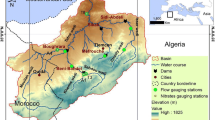Abstract
Poland, like other EU countries, is obliged to implement the Water Framework Directive (2000/60/WE) by the end of 2015. The main objective of the Directive is to provide normative quality of all water resources (surface, underground and coastal sea waters). To reach this goal, reduction of water pollutant emission to the environment is needed. Our project focuses on pollution from agricultural sources which share in global pollution, which is high and growing. This is due to both intensification of agricultural activities and ignoring Agricultural Good Practice Code rules by farmers. In view of the above, this project is expected to provide analysis of selected catchments; especially those exposed to agricultural pollution risk, and propose adjustment strategies for new trends, still keeping in mind environment protection.
Our project concerns the area further called “sensitive area” (according to the rules of Regional Water Management Board in Warsaw). A part of Zglowiaczka river catchments in central Poland was defined as sensitive area (125.3 km2) where reduction of nitrogen and phosphorus run-off from agricultural land to water resources is especially needed. This is a typical agricultural district characterized by good soil quality (predominance of black swampy soil with deep and fertile humus layers). Due to this, it is the first and foremost high quality agricultural land, and almost forestless. The main topic of the research, with the use of the SWAT model, is to propose different means for reduction of migration of P and N to surface waters. Another problem is retention of water for actual and future irrigations. After model verification, calibration and validation, several climatic changes and reclamation strategies will be tested and simulated by the model to find the most effective and profitable solutions.
The project focuses on supporting administration and self-governmental organization in the implementation of effective strategies of catchments management based on a modeling approach. This method enables analysis of trends and early warning system against excessive pollution load. Enhancement of the ecological education level and activation of local population for implementation of EU directives are also very important factors.
Similar content being viewed by others
References
Immerzeel W W, Gaur A, Zwart S J (2008). Integrating remote sensing and a process-based hydrological model to evaluate water use and productivity in a south Indian catchment. Agricultural Water Management, 95: 11–24
Miatkowski Z, Lewinski S, Kowalik W, Soltysik A, Turbiak J (2006). Przydatnosc zdjec satelitarnych Landsat TM do identyfikacji intensywnie odwodnionych siedlisk hydrogenicznych w rejonie KWB Belchatów, Falenty: Wydaw. IMUZ
Mishra A, Froebrich J, Gassman P W (2007). Evaluation of the SWAT model for assessing sediment control structures in a small watershed in India. Transactions of the ASABE, 50(2):469–478
Muleta M K, Nicklow J W (2005). Sensitivity and uncertainty analysis coupled with automatic calibration for a distributed watershed model. Journal of Hydrology, 306: 127–145
Ndomba P, Mtalo F, Killingtveit A (2008). SWAT model application in a data scarce tropical complex catchment in Tanzania. Physics and Chemistry of the Earth, 33: 626–632
Neitsch S L, Arnold J G, Kiniry J R, Williams J R, King K W (2002). Soil and Water Assesment Tool Theoretical Documentation. Texas Water Resources Institute, College Station, Texas
Qiuming C, Connie K, Yinhuan Y, Yong G, Shengyuan Z (2006). GIS modeling for predicting river runoff volume in ungauged drainages in the Greater Toronto Area, Canada. Computers & Geosciences, 32: 1108–1119
Rosenthal W D, Srinivasan R, Arnold J G (1995). Alternative river mmanagement using a linked GIS-Hydrology model. Transaction of the ASAE, 38(3): 783–790
Secchi S, Gassman P W (2007). The cost of cleaner water: Assessing agricultural pollution reduction at the watershed scale. Journal of Soil and Water Conservation, 2007:1–2
Zlonkiewicz M, Labedzki L, Gruszka J (2007). Agricultural irrigation program for Kujawsko-Pomorskie Voivodship, Bydgoszcz
Author information
Authors and Affiliations
Corresponding author
Rights and permissions
About this article
Cite this article
Śmietanka, M., Brzozowski, J., Śliwiński, D. et al. Pilot implementation of WFD and creation of a tool for catchment management using SWAT: River Zglowiaczka catchment, Poland. Front. Earth Sci. China 3, 175–181 (2009). https://doi.org/10.1007/s11707-009-0033-5
Received:
Accepted:
Published:
Issue Date:
DOI: https://doi.org/10.1007/s11707-009-0033-5




